Sonova USA TVCONNECTOR Studio transmitter User Manual ERC
Phonak LLC Studio transmitter ERC
Contents
- 1. User Manaul english
- 2. User Manaul French
User Manaul english
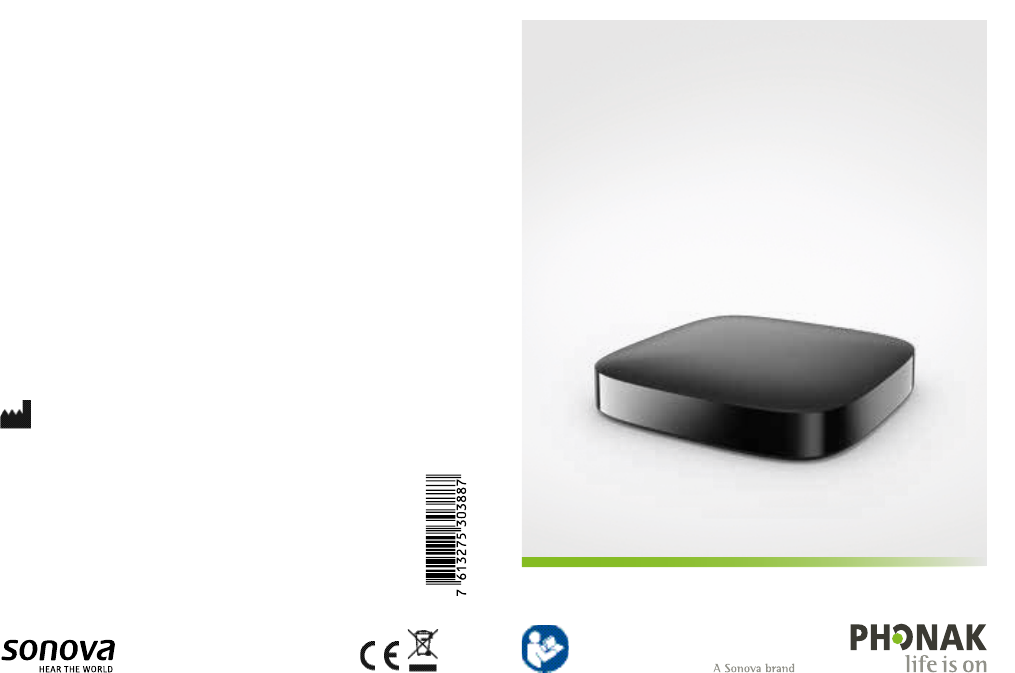
User Guide
TV Connector
029-0515-02/V1.00/2017-03/na © Sonova AG All rights reserved
Manufacturer:
Sonova AG
Laubisrütistrasse 28
CH-8712 Stäfa
Switzerland
www.phonak.com

2 3
Contents
1. Welcome 4
2. Getting to know your TV Connector 5
3. Getting started 8
3.1 Setting up the power supply 8
3.2 Supported audio connections 10
3.3 Connecting to an audio device 11
3.4 Optional: Connecting to an audio device
using a headset socket 12
3.5 Connecting the TV Connector to the
hearing aids 13
4. Daily use of the Phonak TV Connector 15
4.1 TV Connector and phone calls 17
4.2 Switching o audio transmission 17
4.3 Understanding the LED indicator light 18
5. Troubleshooting 19
5.1 Testing the audio transmission 19
5.2 Questions and answers 20
6. Service and warranty 22
6.1 Local warranty 22
6.2 International warranty 22
6.3 Warranty limitation 23
7. Compliance information 24
8. Information and explanation of symbols 28
9. Important safety information 32
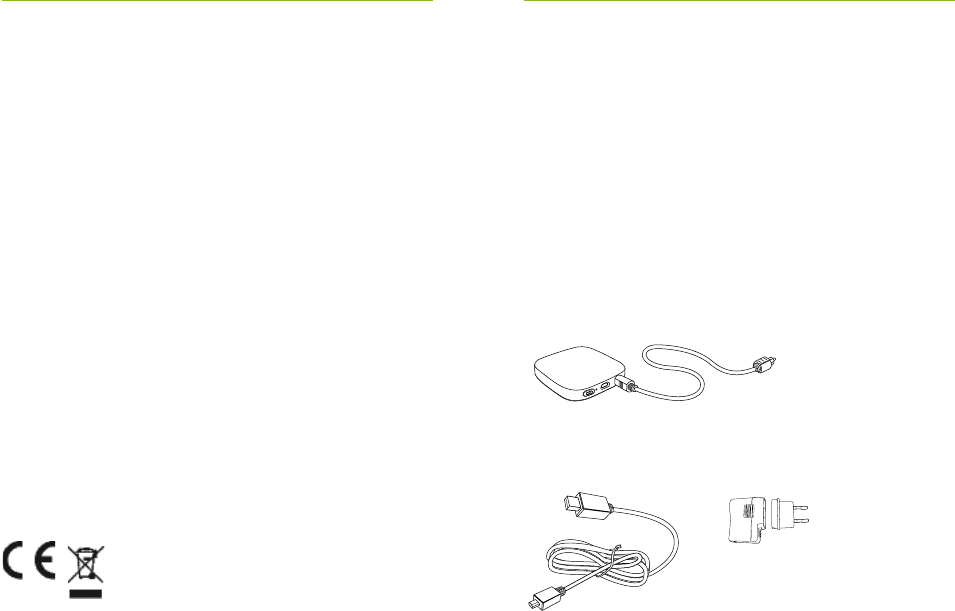
4 5
Congratulations on choosing the Phonak TV Connector.
The TV Connector allows you to connect your hearing
aids to your TV or other entertainment/communication
devices.
Please read this user guide carefully to discover how
to benefit from the features of your TV Connector.
If you have any questions, please consult your hearing
care professional or go to www.phonak.com/tvconnector
Phonak – life is on www.phonak.com
1. Welcome
CE mark applied: 2017
2. Getting to know your
TV Connector
The intended use of the TV Connector is to establish
a wireless connection between your hearing aids
and a TV (or any other audio source). It sends audio
signals within a 15 meter (50 ft) radius wirelessly to
the hearing aids.
Phonak TV Connector is only compatible with Audéo
B-Direct wireless hearing aids.
Audio cable
Power plugUSB cable
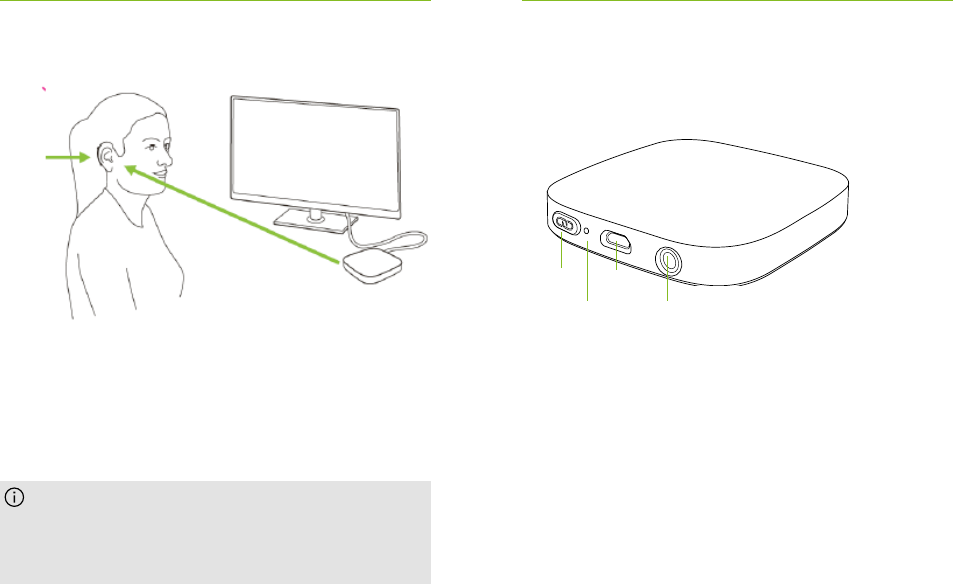
6 7
2.1 Device description
A Connect button
B Indicator light (LED)
C microUSB power socket
D Audio socket for optical (Toslink)
or 3.5mm jack cable
B
AC
D
TV Connector
Hearing
aid
Up to 15 meters
(50 ft)
Line-of-sight between your hearing aids and
the TV Connector is not required. However,
environmental interference like walls or furniture
may reduce the operating range.
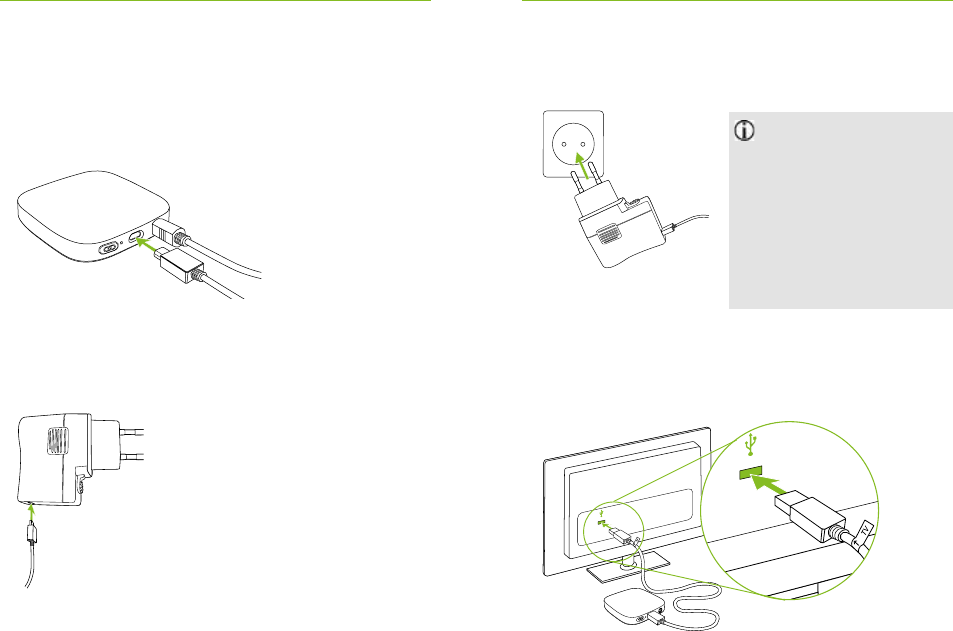
8 9
3. Plug the power supply unit into the socket outlet
of the mains power.
4. Alternatively the TV Connector can be powered via
USB cable on the TV. Insert the larger end of the USB
cable into the USB socket of the TV.
3.1 Setting up the power supply
1. Insert the smaller end of the USB cable into the free
socket of the TV Connector.
2. Insert the larger end of the USB cable into the
power supply unit.
3. Getting started
Upon the very rst time
powering the device,
the connection to the
hearing aids will be
initiated automatically
and the hearing aids will
play a conrmation
tone.
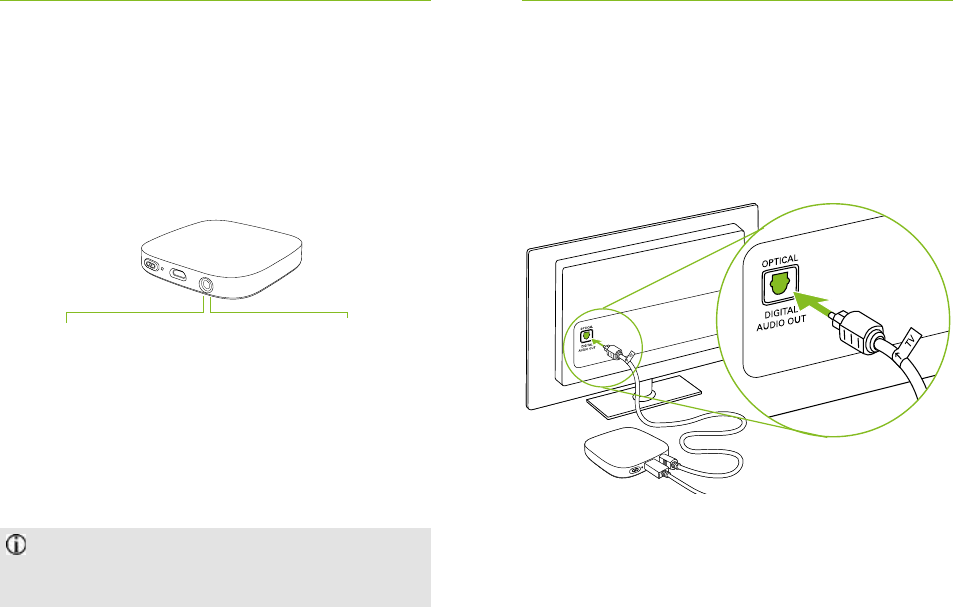
10 11
3.3 Connecting to an audio device
Connect the free end of the optical (Toslink) cable into
the optical OUTPUT of your TV or alternative audio
device.
3.2 Supported audio connections
The TV Connector can be connected to any audio source
such as a TV, PC or HiFi system. It supports two different
audio cable inputs: Optical (Toslink) or Analog. Both of
the audio cables can be plugged into the dedicated
audio socket on the TV Connector.
For best results, we recommend to use the already
attached optical (Toslink) connection, if available on
your TV or alternative audio device.
Always connect the chosen audio cable of the TV
Connector to the audio OUTPUT of your TV or
alternative audio device!
Optical (Toslink)
Digital signal
Fiber optic cable
Analog
Analog signal
3.5 mm jack
(optional)
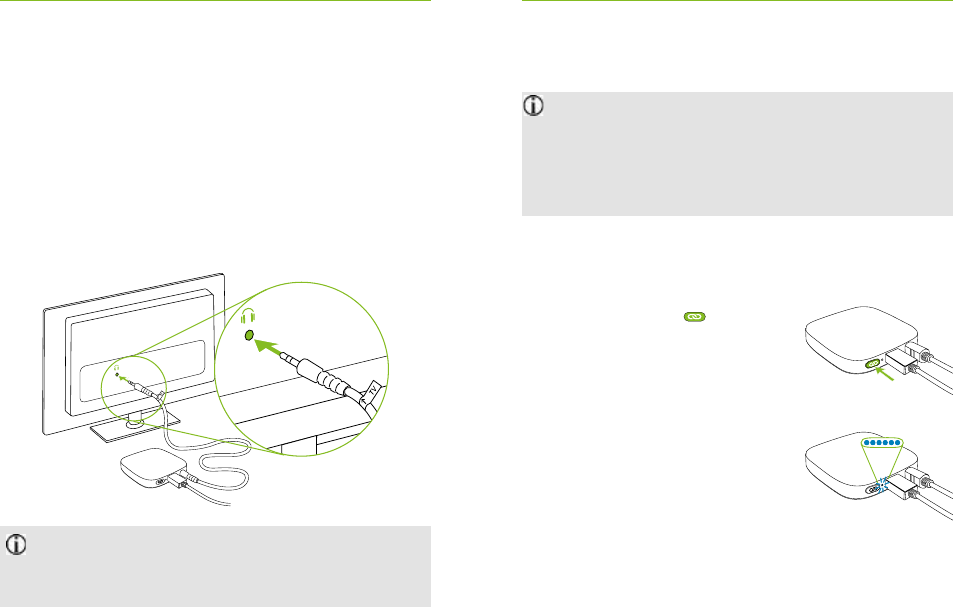
12 13
Some TVs will switch o their loudspeakers when
using the headset socket – the TV will not be
audible for other people.
3.4 Optional: Connecting to an audio device using
the headset socket
If the TV or audio device does not support digital audio
OUTPUT (as shown in chapter 3.3) replace the supplied
optical (Toslink) cable on the TV Connector with the
“Analog 3.5mm jack” cable and insert the other end
into the headset output socket of your TV (or audio
device).
3.5 Connecting the TV Connector to the hearing aids
When the TV Connector is plugged into a power
source the very rst time upon installation, the
connection to the hearing aids will be initiated
automatically and the hearing aids will play a
conrmation tone.
To connect new hearing aids to the TV Connector follow
the steps:
J Press the Connect button
on the back, and the indicator
light will start rapidly blinking
blue.
J Make sure the hearing aids are
switched on and within
1 meter (3 ft) of the
TV Connector.
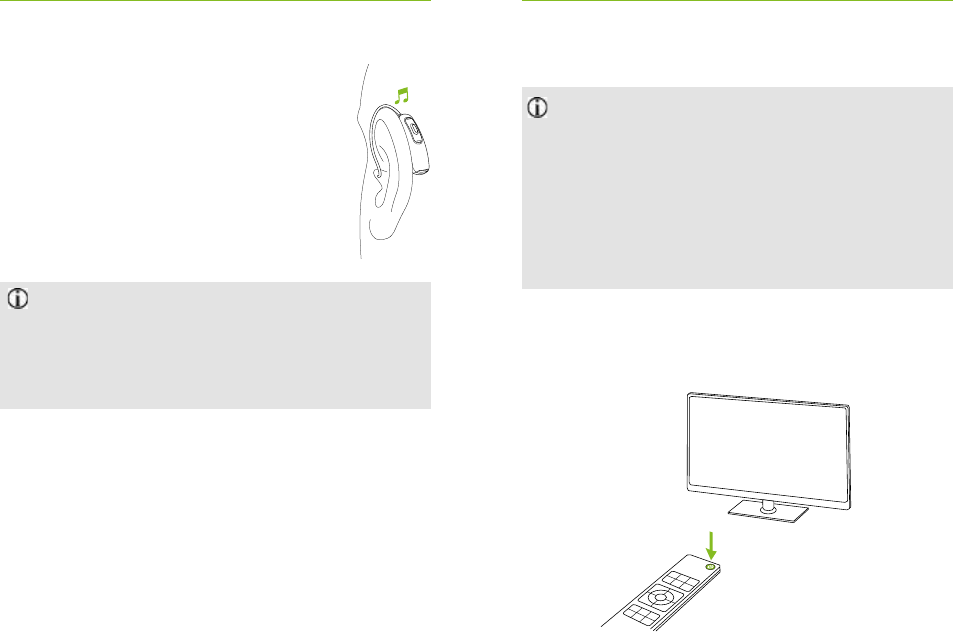
14 15
The TV Connector will connect to any compatible
hearing aid, which is within the range during the
connection process. They will be automatically
connected again after the initial connection
process.
4. Daily use of the TV Connector
The TV Connector can only receive and transmit
audio in mono or stereo. Please make sure that no
Dolby digital or DTS audio settings are used by the
TV (or audio device).
If present, these audio signals will be indicated by
a red LED indicator light on the TV Connector.
Please change the audio signal to stereo (PCM) in
the audio settings menu of the TV.
Switch ON your TV (or alternative audio device). The TV
Connector will automatically transmit the audio signal
to the connected hearing aids.
J You will hear a confirmation
beep in your hearing aids when
the connection was successful.
This may take up to 10 seconds.
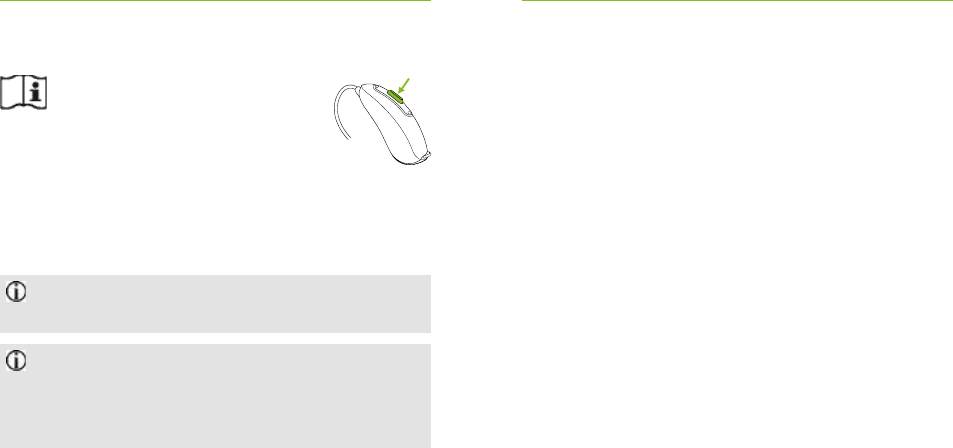
16 17
You will hear the sound of the TV/audio device directly
in your hearing aids.
Make sure the TV or alternative audio device is
switched on.
If no audio input is available, the TV Connector
automatically stops the audio transmission to the
hearing aids. The indicator light will glow red
(standby mode).
If the hearing aids are out of range of the TV Connector
the audio transmission will be terminated. Once the
hearing aids are back into the range of TV Connector,
the audio signal will automatically resume streaming.
You might accept the incoming
audio signal on the hearing aid
by pressing the hearing aid button.
For more detailed explanation refer
to the hearing aid user guide.
4.1 TV Connector and phone calls
If the hearing aids are connected to your cell phone,
you can still receive phone calls, even when using the
TV Connector.
In case of an incoming call, the hearing aids automatically
stops the audio signal from the TV Connector and the
alerts will be played signalizing to the incoming call. After
the call the hearing aids automatically switch back to the
TV Connector audio signal.
4.2 Switching o audio transmission
To end the transmission of the audio signal, simply
switch o the TV or other connected audio source.
The TV Connector will go into the standby mode
automatically.
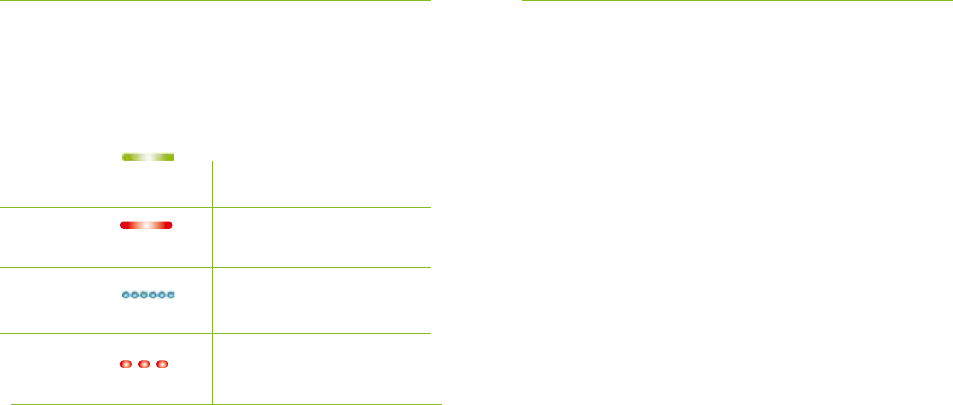
18 19
4.3 Understanding the indicator light (LED)
Solid green Switched on and
transmitting audio
Solid red Switched on and
no audio input
Rapid blinking Connecting mode
blue
Blinking red Wrong audio input
5. Troubleshooting
5.1 Testing the audio transmission
If you cannot hear the sound from the audio source (e.g.
TV), check the following options:
J Test the connection of the TV Connector to the
hearing aids
J Go through the steps described in chapter 3.5
J Test the connection of TV Connector to the audio
device (e.g. TV)
J Switch on the audio device
J Make sure all cables are inserted properly into the TV
Connector and the audio device (e.g. TV)
J Make sure the audio cable is plugged into the audio
OUT plug of the audio source (e.g. TV)
J Check if the indicator light is solid green

20 21
5.2 Questions and answers
A summary of frequently asked questions and answers:
I don‘t hear any sound although the TV is switched on and
connected to the TV Connector.
J No audio input available at
the TV Connector.
The indicator light is solid green but I cannot hear the TV.
J The TV Connector is not
connected to the hearing
aids.
J Check if the optical cable
(Toslink) or 3.5mm
(analog) is inserted into
the TV Connector and the
audio source properly.
J Check that the audio cable is
inserted at the audio output
of the audio source (e.g. TV).
J Connect your hearing aids as
described in chapter 3.5
CausesCauses What to doWhat to do
J If TV Connector is
connected to the optical
(Toslink) socket of your
TV, adjust the volume by
using the volume
buttons of your hearing
aids or the ambient
balance functionality.
J Check the audio settings
of the TV to enable the
loudspeakers to be used in
parallel.
The volume during streaming is not comfortable
(too low or too high).
J The different TV audio sources
have different output volume
(
After connecting the TV Connector the TV loudspeaker is
switched o.
J You have selected the headset
output of the TV set

22 23
6. Service and warranty
6.1 Local warranty
Please ask the hearing care professional, where you
purchased your devices, about the terms of the local
warranty.
6.2 International warranty
Phonak oers a one year limited international warranty,
valid as of the date of purchase. This limited warranty
covers manufacturing and material defects. The warranty
is valid only if proof of purchase is shown.
The international warranty does not affect any legal
rights that you might have under applicable national
legislation governing sale of consumer goods.
Authorized hearing
care professional
(stamp/signature):
6.3 Warranty limitation
This warranty does not cover damage from improper
handling or care, exposure to chemicals, immersion in
water or undue stress. Damage caused by third parties or
non-authorized service centers renders the warranty
null and void. This warranty does not cover any services
performed by a hearing care professional in his/her oce.
Serial number:
Date of purchase:

24 25
7. Compliance information
Europe:
Declaration of Conformity
Hereby Sonova AG declares that this product is in
compliance with the essential requirements of the
Medical Devices Directive 93/42/EEC as well as the Radio
Equipment Directive 2014/53/EU. The full text of the
Declaration of Conformity can be obtained from the
manufacturer or the local representative whose address
can be taken from www.phonak.com
Australia/New Zealand:
Indicates a device’s compliance with applicable
Radio Spectrum Management’s (RSM) and
Australian Communications and Media Authority
(ACMA) regulatory arrangements for the legal sale
in New Zealand and Australia.
The compliance label R-NZ is for radio products
supplied in the New Zealand market under
conformity level A1.
Notice 1:
This device complies with Part 15 of the FCC Rules
and with with Industry Canada‘s license – exempt RSSs.
Operation is subject to the following two conditions:
1) this device may not cause harmful interference, and
2) this device must accept any interference received,
including interference that may cause undesired
operation.
Notice 2:
Changes or modifications made to this device not
expressly approved by Sonova AG may void the FCC
authorization to operate this device.
Notice 3:
This device has been tested and found to comply
with the limits for a Class B digital device, pursuant
to Part 15 of the FCC Rules and ICES-003 of Industry
Canada.
These limits are designed to provide reasonable
protection against harmful interference in a residential
installation. This device generates, uses and can radiate
radio frequency energy and, if not installed and used in

26 27
accordance with the instructions, may cause harmful
interference to radio communications. However, there
is no guarantee that interference will not occur in a
particular installation. If this device does cause harmful
interference to radio or television reception, which can
be determined by turning the equipment off and on,
the user is encouraged to try to correct the interference
by one or more of the following measures:
J Reorient or relocate the receiving antenna.
J Increase the separation between the device and
receiver.
J Connect the device into an outlet on a circuit dierent
from that to which the receiver is connected.
J Consult the dealer or an experienced radio/TV
technician for help.
Notice 4:
Japanese Radio Law Compliance. Business Law
Compliance. This device is granted pursuant to the
Japanese Radio Law (電波法). This device should not be
modied (otherwise the granted designation number will
become invalid).”
More details can be found in the data sheet which can
be downloaded from www.phonak.com/tvconnector
Notice 5:
FCC/Industry Canada RF Radiation Exposure
Statement
This equipment complies with FCC/Industry Canada RF
radiation exposure limits set forth for an uncontrolled
environment.
This equipment should be installed and operated with a
minimum distance of 20 cm between the radiator and
your body.
This transmitter must not be co-located or operating in
conjunction with any other antenna or transmitter.
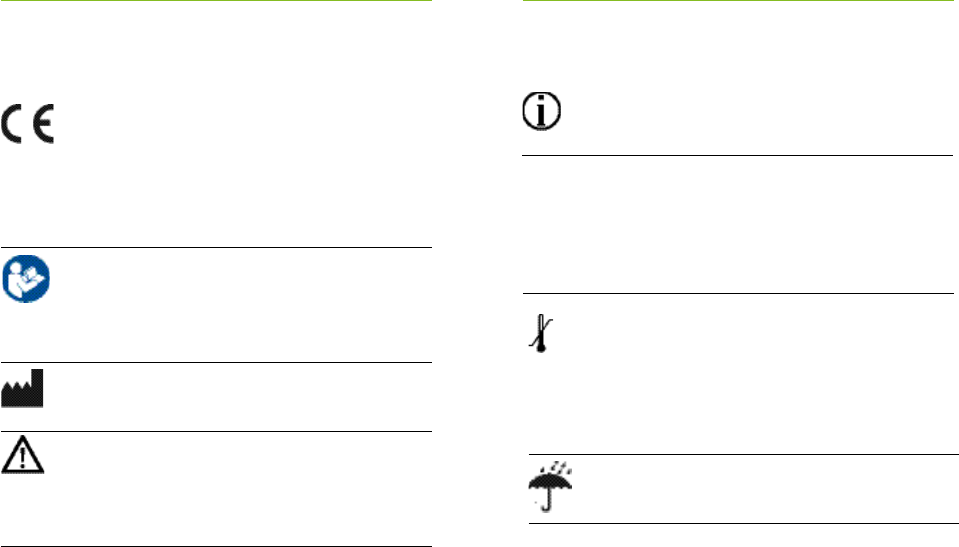
28 29
This symbol indicates that it is
important for the user to read and take
into account the relevant
information in this user guide.
The CE symbol is confirmation by
Sonova AG that this product meets
the requirements of the Medical
Devices Directive 93/42/EEC as well
as the Radio Equipment Directive
2014/53/EU.
8. Information and explanation of
symbols
Operating
conditions
Important information for handling
and product safety.
This symbol indicates that it is
important for the user to pay attention
to the relevant warning notices in this
user guide.
The device is designed such that
it functions without problems or
restrictions if used as intended, unless
otherwise noted in this user guide.
Indicates the device manufacturer, as
dened in EU Directive 93/42/EEC.
Temperature transport and storage:
–20° to +60° Celsius
(–4° to +140° Fahrenheit).
Temperature operation:
0° to +40° Celsius
(+32° to +104° Fahrenheit).
Keep dry.
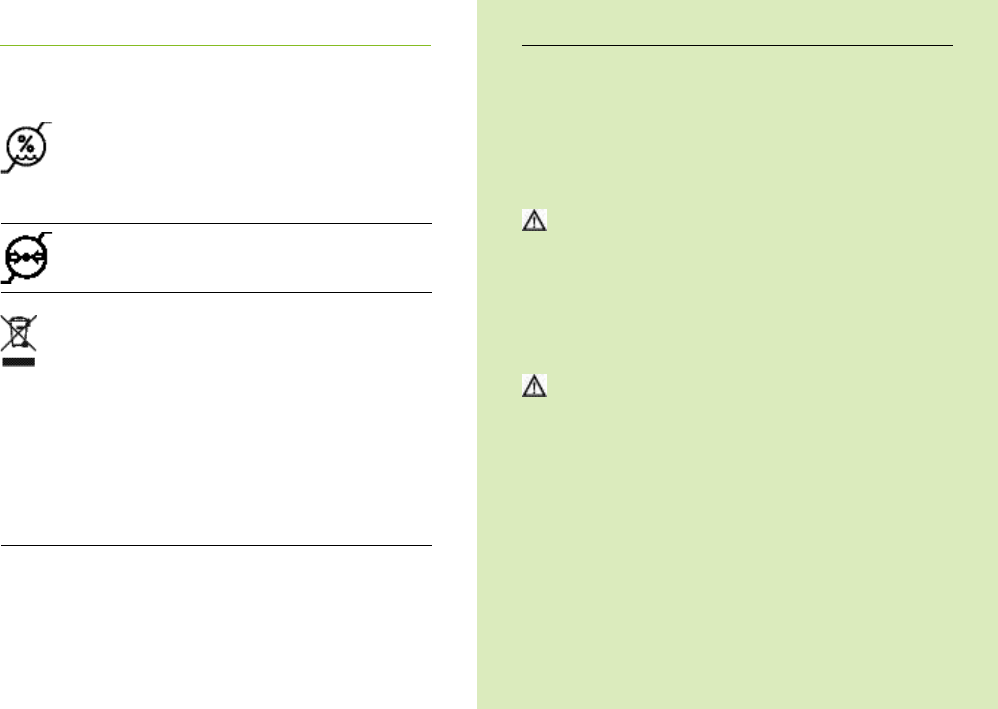
31
30
8. Information and explanation of symbols
Humidity during transportation and
storage: <90% (non-condensing).
Humidity operation: <90% (non
condensing).
Atmospheric pressure: 500 hPa to
1100 hPa.
This symbol on the product or its
packaging means that it should not be
disposed of with your other household
waste. it is your responsibility to dispo-
se of your waste equipment separately
from the municipal waste stream. The
correct disposal of your old appliance
will help prevent potential negative
consequences for the environment and
human health.
Please read the information on the following pages
before using your device.
Hazard warnings
This device is not for children below 36 months.
It contains small parts that can cause choking, if
swallowed by children. Keep out of reach of
children and mentally challenged people or pets. If
swallowed, consult a physician or hospital
immediately.
Phonak devices may generate magnetic elds. Tests
that Phonak conducted showed that no interferences
with the Implantable devices (e.g. pacemakers,
debrillators, etc.) were caused that would impact the
safe and eective use of the Implantable devices.
Users of Implantable devices should contact their
doctor and/or the manufacturer of the Implantable
device before they start using a Phonak device. Stop
using the Phonak device if any inuence of the
Phonak device on the Implantable Device is
experienced and contact the manufacturer of the
Implantable device for advice.
9. Important safety information
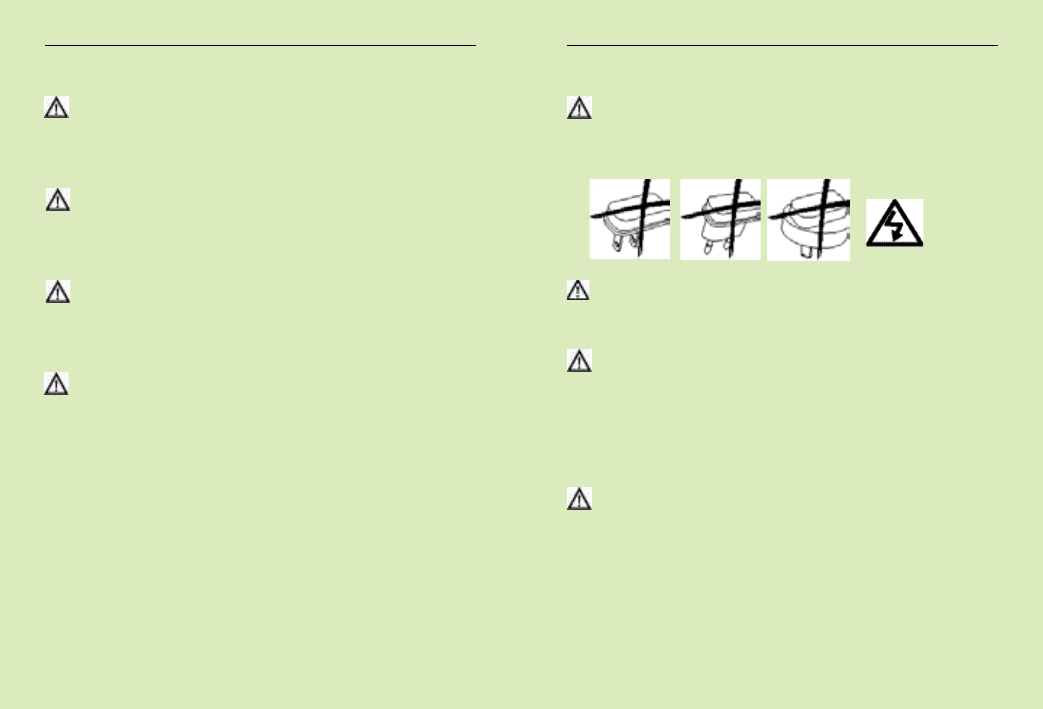
32 33
Use only hearing aids that have been specially
programmed for you by your hearing care
professional.
Dispose of electrical components in accordance with
your local regulations.
Changes or modifications to any of the devices
that were not explicitly approved by Sonova AG are
not permitted.
External devices may only be connected if they
have been tested in accordance with corresponding
IECXXXXX standards. Only use accessories approved
by Sonova AG.
For safety reasons, only use chargers supplied by
Sonova AG or stabilized chargers with a rating of
5 VDC, min. 500 mA.
Caution: electric shock. Do not insert plug alone into
electrical outlets.
Do not use the device in explosive areas (mines or
industrial areas with danger of explosions,
oxygen rich environments or areas where ammable
anesthetics are handled) or where electronic
equipment is prohibited.
Opening the device might damage it. If problems
occur which cannot be resolved by following the
remedy guidelines in the troubleshooting section of
this user guide, consult your hearing care professional.
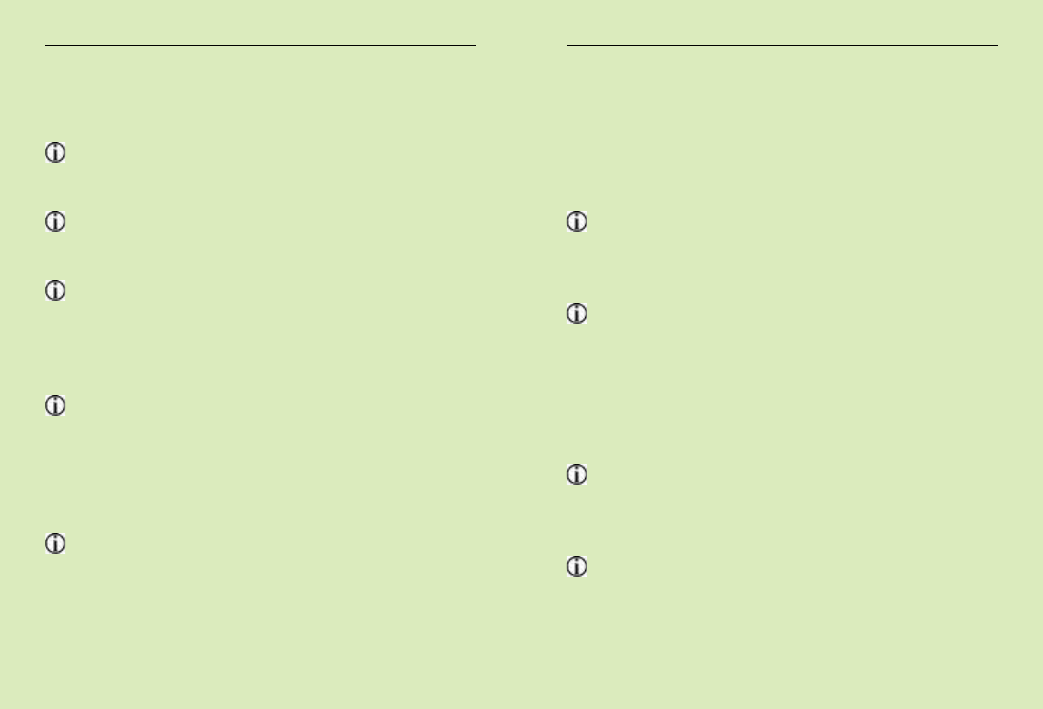
34 35
Product safety information
Protect the device connectors, plugs, power supply
from dirt and debris.
Do not use excessive force when connecting your
device to its different cables.
Protect the device from excessive moisture (bathing
or swimming areas) and heat sources (radiator).
Protect devices from excessive shock and
vibration.
Clean devices using a damp cloth. Never use
household cleaning products (washing powder, soap,
etc.) or alcohol to clean them. Never use a
microwave or other heating devices to dry any of
the devices.
The digitally coded, inductive transmission
technology used in this device is extremely reliable
and experiences virtually no interference from
other devices. It should be noted, however, that when
operating the system near computer equipment,
larger electronic installation or other strong
electromagnetic fields, it may be necessary to be at
least 60 cm (24") away from the interfering device
to ensure proper operation.
X-ray radiation, CT or MRI scans may destroy or
adversely affect the correct functioning of the
device.
If the device has been dropped or damaged, if it
overheats, has a damaged cord or plug, or has been
dropped into liquid, stop using your device and
contact authorized service centre.
Other important information
High-powered electronic equipment, larger electronic
installations and metallic structures may impair and
signicantly reduce the operating range.
Protect your eyes of the optical light from the optical
Toslink cable when plugged into the device or TV.
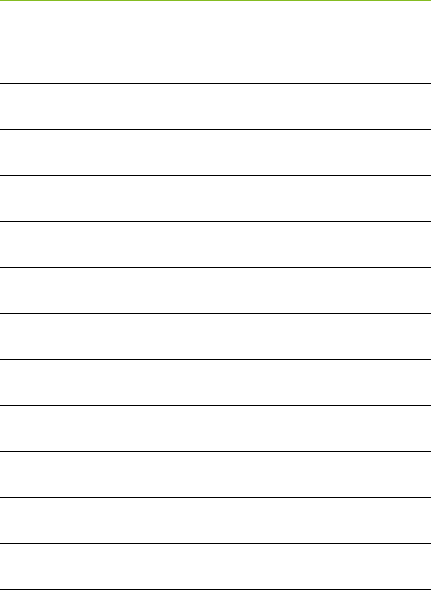
36
Notes